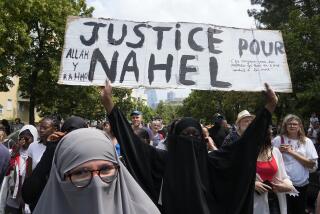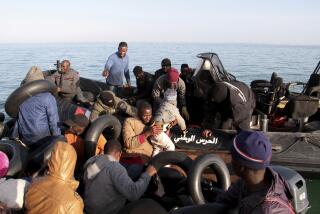The Arabian Nights in the Land of Ali Baba
- Share via
TANGIER, Morocco — There I was, camera ready, in the land of Ali Baba, ready to shoot a colorful scene. The setting was the country market in Tangier, called a souk or socco in Arabic.
There were plucked chickens hanging neatly in rows on overhead poles, and a hand-waving butcher in animated discussion with a heavily veiled Muslim woman. They were haggling over how many dirhams it costs to put a roast chicken on the dinner table in today’s Moroccan economy.
Just as I was ready to put my motor drive on go, the woman in black spotted my camera, pulled her veil close, covered her face and marched off. I missed the picture, the Moroccan housewife left the market empty-handed, and the chicken man lost a sale. My camera suddenly took on the dimensions of an albatross around my neck. From then on I was discreet when taking pictures.
Traveling in Morocco is like stepping into an Arabian Nights tale, a frozen moment in time. Of course, a lot of what you see in Tangier is for the tourist, but you don’t have to go far to see the way of life as it is today and as it has been for hundreds of years. A blend of Old Testament and the 1980s.
Bright, Open City
Tangier is a bright, open city. And while there are still those who would like to sell you goods and guides off the sidewalk, it’s not much different from other cities on the tourist circuit.
Most of the population is Muslim, with a Jewish section and a Christian neighborhood that curiously is called Little California because it’s built on San Francisco-type hills. The hills overlook the modern port, as well as colorful fishing boats.
Wandering the town takes you to the casbah. Tangier’s casbah (meaning “fort”) is made up of the old palace, plus a multitude of narrow walkways, alleys and stairways that wind past squat, flat-roofed structures jutting out from the hillside. Many people live in the casbah, and their way of life hasn’t changed significantly for centuries.
As we passed through one narrow alley, the aroma of fresh bread filled the street. We began looking for a bakery and instead discovered the neighborhood “public oven shop.”
Before reaching the shop we saw 15 or 20 wooden boards lined up on the ground alongside the building. The boards had round loaves of rising bread dough huddled under a variety of colored cloths. Also lined up were pans of meals already baked; most held vegetables in sauces, a few had delightful-smelling chickens.
These for-hire ovens are everywhere in Morocco because most folks don’t have ovens in their homes. The cost for the service is 40 centimes, about 9 cents. We asked one of the young oven tenders how anyone knew whose bread belongs to whom? “They know, and take only their own,” he said.
From the casbah we wandered toward the socco with its many bazaars. Most of the shops are for tourists, but once we were into the country marketplace we found a whole new world of intrigue, leaving all signs of tourism behind.
The country market is the most colorful part of Tangier, teeming with buyers and sellers. Your senses are bombarded with a cacophonous mixture of extraordinary sounds, sights and smells.
Of the hundreds of stalls, some are open, some are in dilapidated wooden buildings, some are protected from the African sun with an unlikely flowered beach umbrella, while others are covered with a torn canvas.
The distinct aromas of immense heaps of exotic herbs and spices float through the air, adding to the special aura of the socco. Wooden counters groan under high stacks of round loaves of Arab bread.
One man stood blocking a walkway with bars of an unattractive gray substance stacked on an old wooden crate, singing a repetitive chant that seemed to attract women. He would cut off a butter- cube-size chunk, wrap it in a scrap of paper and trade it for a coin. Hardly a woman passed him without buying. We finally satisfied our curiosity and found that he was selling yeast.
Plucked chickens hung above the shoppers, and below them rows of live chickens that looked hypnotized waited patiently to be chosen.
Brilliant Color
Yellow melons were mounded in large piles, splashing brilliant color against the drab buildings of the socco . Vendors hawked their wares and children stood in line to buy a penny cup of lemonade from a dingy, antiquated pushcart. The whole feeling was of a country fair. It was there that we discovered the Riff people of the Berber tribe.
The indigenous peoples of Morocco are Berbers. The origin of the name is thought to come from the Greek and/or Roman word for barbarians. Ancient Egyptian monuments depict them as a blond race. Most Berbers are tawny-skinned, but even today some of the Riffs (northern Berbers) are fair and blond, with beautiful hazel eyes.
They don’t like a camera pointed their way and are quick to tip straw hats over their faces if they see it.
The women conduct family business at the market, while husbands wander the socco or find a shady spot to have a glass of hot mint tea with the other men.
For the women, market day is a social time. Sitting side by side on straw mats with their pretty babies, they chat and enjoy female companionship often missed in their nomadic life style.
Their meager offerings of tomatoes, small baskets of chili peppers, cactus apples or figs are sold or bartered for simple necessities such as oil, sugar and grains.
We watched as long-robed shoppers observed a man gulp a lick of flame in quiet amazement, and another group watched a daring performer gaze into the eyes of a cobra to the tune of a tinny, pot-bellied flute. All done for a few coins across the palm.
These people live in the Riff mountains that sprawl for miles along the coast. The range forms a rock barrier and for years isolated the native tribes. The invaders that have most affected the Berber race are Arabs, but although they have a common religion, tribal groupings and often a government, they have failed to amalgamate to any great degree because of their isolation.
They come to the city market with their ancient customs and dress. The men wear long, hooded brown robes (djellaba) and the women all wear bright, red-striped skirts called foutas . They drape a shawl over their heads and top that with a large brimmed straw hat decorated with multi-hued wool pompons. Frequently a baby rides hidden on its mother’s hip under layers of cloth.
At the end of the day, purchases are packed into large floppy baskets, then slung on each side of a tiny donkey usually ridden by the husband, while wife and children trail behind as they head for their mountain homes. The life style of the Riff hasn’t changed in hundreds of years.
Tangier may or may not be for you. If yes, hurry--changes are afoot. Tourism has planted its seed and will most certainly grow. Visit Morocco before the eye of your camera captures the once-fierce Berbers of the Riff wearing baseball caps and tennis shoes.
Travelers planning to visit Spain will find a side trip to Tangier quick and easy. Hydrofoils depart from Tarifa (near Gibraltar) daily and cross the strait in 30 minutes. The boat leaves in the morning, and for those who don’t plan on spending the night, it returns in the late afternoon. The other option is a ferry from Tarifa that takes two hours and costs about $17 round trip.
More to Read
Sign up for The Wild
We’ll help you find the best places to hike, bike and run, as well as the perfect silent spots for meditation and yoga.
You may occasionally receive promotional content from the Los Angeles Times.






